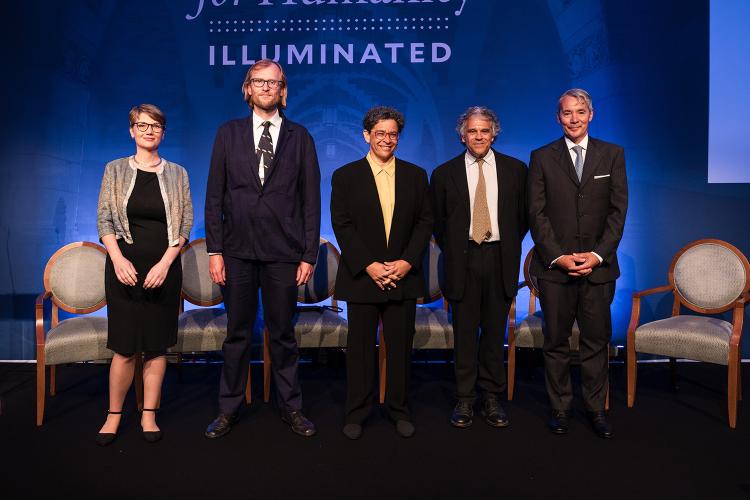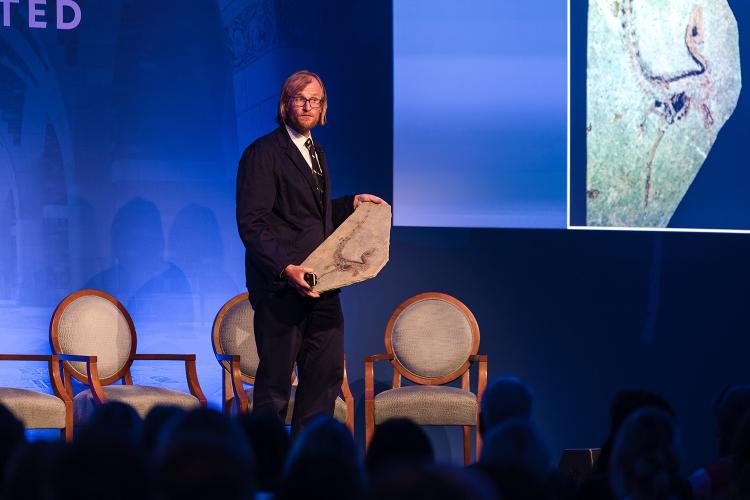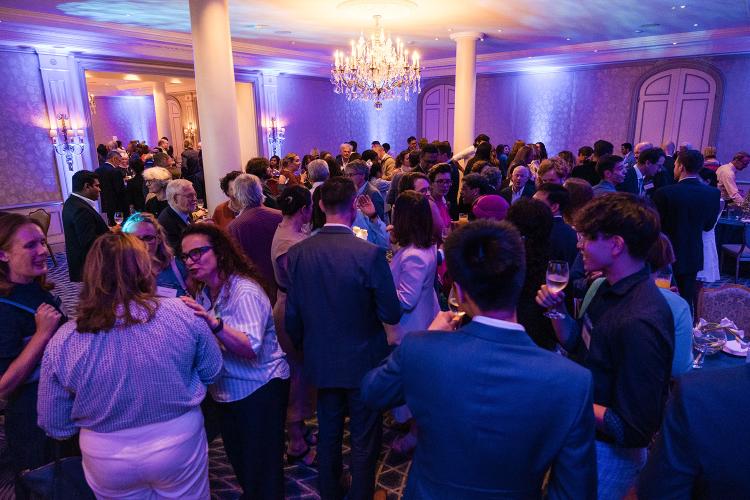What color were dinosaur feathers? How are smartphones transforming museums? What can a book’s dust jacket tell us about literary culture in the 1920s? These are just some of the questions researchers and scholars are answering using Yale’s natural and cultural history collections.
On June 21, over 300 members of the Yale community gathered at the Savoy Hotel in central London to hear from some of the Yale experts who are advancing breakthroughs in conservation, facilitating greater access to collections, and uncovering secret histories of some of the world’s greatest treasures.
The first international installment in the For Humanity Illuminated event series, “Collections and Cultural Heritage in the Digital Age” featured five speakers who guided the audience through an exploration of groundbreaking work at Yale and beyond to preserve artifacts and objects while achieving greater democratization in the management of collections.

Interpreting Our Past to Shape Our Future
As associate curator of the Yale Babylonian Collection, Agnete Wisti Lassen uses technology to discover new findings in a legacy collection that comprises over 45,000 artifacts from ancient Mesopotamia—many of which were acquired by Yale more than a century ago. She and her colleagues recently analyzed traces of organic residue inside an Egyptian alabaster vase presented to King Xerxes of Persia, revealing that it once contained an opium concoction. This finding has opened new lines of inquiry, revitalizing scholarly interest in an object more than 2,500 years old. Lassen’s work is also focused on sharing the collection with researchers around the world through a careful digitization process that has revolutionized the study of cuneiform seals.
In a lyrical meditation, Gavin Hogben, senior critic at the Yale School of Architecture, contemplated possibilities for new dimensions in museum environments made possible by advancing mobile technology. As today’s museums invest more in hosting workshops, demonstrations, and residencies in their galleries, “collections often now grow by generating objects from one-time events and performances that only can be recalled with live-capture devices and mobiles,” he noted. Technology is enhancing the agency of museum-goers themselves “as makers and as performers, and as on-demand curators of their collections of museum experiences.”
How can you read a book without reading the text? One answer to this quasi-riddle posed by Jacqueline Goldsby ’98 PhD is to read a book’s physical characteristics, paying close attention to features such as its binding, dust jacket design, end papers, typefaces, and copyright page. These material details are recorded by scholars in what is known as a descriptive bibliography. Goldsby, the Thomas E. Donnelly Professor of African American Studies and of English, is co-director of the Black Bibliography Project, a research initiative that is building a digital database of descriptive bibliographies for works by African American writers. Using “linked data”—a web-based technique for recording meaningful relationships between and among data drawn from disparate sources—Goldsby and an interdisciplinary team of librarians, curators, and graduate students are working to recover evidence of the networks of human actors, institutions, technologies, and locales that brought Black print into social life and literary history.
Art conservator Paul Messier, founder and Pritzker Director of the Lens Media Lab (LML) at Yale’s Institute for the Preservation of Cultural Heritage, leads a collaborative team of researchers dedicated to understanding and interpreting the material history of the twentieth century photographic print. The LML houses the world’s largest reference collection of photographic paper—the genome of black and white photography—and manages its preservation and access for teaching and learning. Approaching cultural heritage collections as datasets, the LML is forming numerous fruitful collaborations across Yale and more broadly with partners in many of the world’s leading collecting institutions. “We hold cultural heritage collections in trust, and we trust that generations to come will find identity and enrichment and new meanings, just as we do,” he said.
While studying ancient squid fossils under an electron microscope at Yale, paleontologist Jakob Vinther ’11 PhD was struck with an idea that led him and a team of researchers to discover the presence of melanin in fossilized dinosaur feathers. This revelation eventually made possible the first ever realistic reconstruction of color patterns in feathered dinosaurs. The clues they uncovered about the physical appearances of extinct species, in turn, have led to intriguing new insights into their behaviors and habitats. Scientists still have much to learn about paleocolor, and the enormous ramifications of Vinther’s breakthrough continue to evolve today.

Preserving Our Shared History
Following their presentations, the five speakers joined a panel discussion moderated by Susan Gibbons, vice provost for collections and scholarly communication, about the value of object-based teaching and the importance of engaging with and exploring the tension between physical collections and digital technologies.
President Peter Salovey ’86 PhD, closed the program with reflections on Yale’s role as trusted steward of its collections. One of his favorite assignments for his social psychology students, he noted, required them to find a work of art in one of the university’s museums, libraries, or galleries depicting mental or psychological illness. “These encounters with original works of art can cultivate empathy, rouse our imagination, and broaden our understanding. Those skills enable students to respond successfully to challenges and opportunities in every sector after they graduate,” Salovey said.
“The thirty million items within Yale’s collections are instruments of future discovery,” he went on to say. “Because the strength of our collections underpins the strength of our scholarship, preservation has been codified as a central pillar of Yale’s mission. Cultural heritage, in its essence, defines humanity. Supporting the preservation of our collections is therefore a major priority of the For Humanity campaign.”

Next: Washington, DC, and Boston
For Humanity Illuminated returns to the US this fall with events in Washington, DC, on October 24, and Boston on November 9. Visit the For Humanity Illuminated page to stay up to date on upcoming events and watch recordings of past programs.
